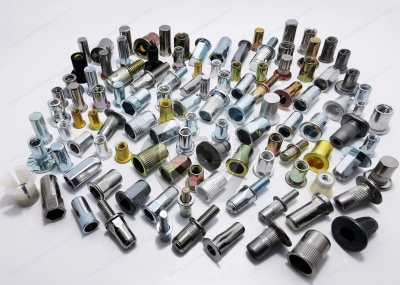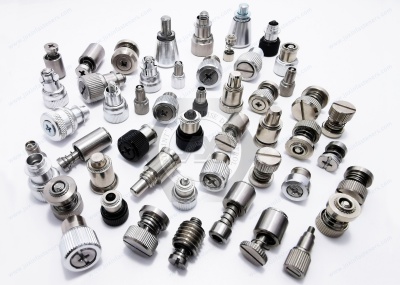Call Us
+86 136 6007 9809
Call Us
+86 136 6007 9809
Jun. 22, 2024
Self-clinching fasteners and Captivated screws Panel Fastener Installations industry solutions
Captivated screws: Captivated screws (also known as captive fasteners or captive bolts) typically involve multiple parts, which leads to relatively higher costs and higher stakes for manufacturers. This leads to a greater specialization in features with different combinations depending on the application. But the basic concept has a screw-retained in a panel either directly or through a separate retainer, which adds a radius to the first few threads to ensure proper alignment. Some products have a knob cap screw or thumb screw meant for tool-less installation, while others may recess the screw within the retainer to discourage disassembly by hand.
Application
The main problem captivated screws are meant to solve to minimize the number of loose parts in an assembly, often to aid in production or consumer use. For example, electric car charging stations involve the use of very high voltages, and loose hardware has the potential to cause a short circuit. To avoid a potential fire hazard, a simple screw with a threaded end more comprehensive than the shaft is retained within the cover plate of the charging station by deforming the panel around the hole after inserting the screw. This allows service technicians to assemble the station without dropping hardware.
Alternative Solutions
Loose screws are an alternative in this case and would be more cost-effective to source. They also remove a step in the manufacturing process that involves installing the captivated screws into the panel, potentially decreasing production time. However, each loose part has an increased risk of being lost in transit, installed in the wrong location, or causing short circuits. The value gained from the time required to retain screws in a cover plate is the more robust guarantee of safety and easier on-site assembly.
Common Attachment Technologies
One of the features that lend to the wide variety of captivated screw combinations is how the screw or its retainer is attached to a panel or PCB. They regularly utilize surface mount technology (SMT), broaching, and self-clinching. More unique methods include flare-mounting with a floating option, which deforms the retainer to accommodate attachment to easily clinched or broached materials.
Panel fastener, Captive Panel Screw-Low Profile Knob, Spring-loaded is different from a regular screw. It is a combination of several parts with a spring-loaded center.


Flare-In Captive Panel Screws: The base flares out during installation, creating a backside flange in hard materials and near edges in panels up to 0.312" thick. Install with a flare-in installation tool and an arbor press. They require a 90° flared hole. Screws become a part of the panel when installed, so they won't fall out and get lost. They are often used with surface mount nuts.
18-8 stainless steel bodies are chemical resistant and may be mildly magnetic.
Aluminum bodies resist corrosion in wet environments and are nonmagnetic.
Press-Fit Captive Panel Screws: Install in a soft material such as aluminum and low-carbon steel at least 0.036" thick with an arbor press or similar pressure tool. Screws become a part of the panel when installed, so they won't fall out and get lost. They are often used with surface mount nuts.
18-8 stainless steel bodies provide good chemical resistance and may be mildly magnetic.
Zinc-plated steel bodies resist corrosion in wet environments.
1. Pressure riveting type of spring screw installation steps:
(1) Put the loose screws into the base with grooves
(2) Punch the corresponding mounting holes in the sheet metal.
(3) Lay the sheet flat on the screws.
(4) Evenly press the riveting equipment.
(5) Complete the installation
Note: Before riveting, the pressure parameters of the riveting machine should be adjusted to the appropriate value. When riveting, the upper and lower molds should be kept parallel and riveted in place at one time to ensure that the sheet and riveting sleeve are completely riveted flat and without gaps.
2. Expansion riveting type Large Knob, Spring-loaded installation method
By expansion, riveting riveted to the thin plate and fixed to the thin plate. Suitable for applications near the edge of the mounting plate, The mounting force is not large and can be applied to panels of different hardnesses. The back of the mounting surface is kept flush after installation. In most cases, no matter how thin the mounting plate can be, this product also applies to painted panels.
3. Floating Large Knob, Spring-loaded mounting method
(1) Place the loose rivet into the base tool with a groove
(2) Punch out the corresponding size of mounting holes on the panel and punch the holes
(3) Place sheet flat on top of spring screws
(4)Adjust the relevant parameters of the riveting equipment and press evenly to flare the locating ring
(5)Rivet flat has completed the installation
For high-quality Self-clinching fasteners and Captivated screws Panel Fastener and professional technical support, ddon'thesitate to co ddon'tus at adelajonly@gmail.com or visit our website at [Juxin Fasteners]: https://www.juxinfasteners.com.
Contact Us
Tel.:
+86 020 8621 0320
+86 020 3121 6067
Technical Support:
Navigation
SEND INQUIREY